| Manufacturer: | Model Minutes  |
![[Picture]](/images/archive/images/ratings/rating_mm_space_racer.gif) (02/01/03) I picked up a
link to Model Minutes off of RMR some time ago and thought the rockets they had
were unique looking, but that was only half of it. The other unique
characteristic of the Model Minutes' rockets is that they are paper. Maybe they
can say it better: "Model Minutes is a company specializing in the
creation and manufacturing of paper and cardboard models. We are proud to
launch a new line of rockets assembled from paper and cardboard. It has been
derived from a European technique which makes use of parts cut out from
cardboard. All of our assembly kits come with a set of instructions illustrated
with 3-D images."
(02/01/03) I picked up a
link to Model Minutes off of RMR some time ago and thought the rockets they had
were unique looking, but that was only half of it. The other unique
characteristic of the Model Minutes' rockets is that they are paper. Maybe they
can say it better: "Model Minutes is a company specializing in the
creation and manufacturing of paper and cardboard models. We are proud to
launch a new line of rockets assembled from paper and cardboard. It has been
derived from a European technique which makes use of parts cut out from
cardboard. All of our assembly kits come with a set of instructions illustrated
with 3-D images."
By the way, the Minute in Model Minutes is not pronounced "min'it" like the time unit, but rather "mie nuet" like something small.
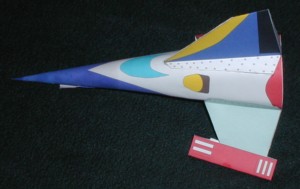 I chose a couple of the Model Minutes kits, the Space Racer and
the pair of High Performance rockets that are in a single kit. There are two
ways that you can purchase the rocket kits. First, as a kit that comes to you
in a plastic bag for your assembly and second, is on a CD-ROM. Yes, that is
right, on a CD-ROM where you would then print the designs at home onto
card-stock paper.
I chose a couple of the Model Minutes kits, the Space Racer and
the pair of High Performance rockets that are in a single kit. There are two
ways that you can purchase the rocket kits. First, as a kit that comes to you
in a plastic bag for your assembly and second, is on a CD-ROM. Yes, that is
right, on a CD-ROM where you would then print the designs at home onto
card-stock paper.
The Space Racer kit came with neatly packaged and included the rocket printed on (2) 8½ x 11" card-stock pages. My kit included a second rocket in a different color scheme. I'm not sure if this is standard. Also included was a small piece of ¼" foamboard that is used for the motor mount. A piece of household drinking straw is provided for the launch lug. There is a wire motor retainer and a piece of thread that is used with the motor retainer. In addition, a silver Mylar parachute, shroud lines and a rubber band shockcord are provided for the recovery system. Clay for the nose weight is also included.
CONSTRUCTION:
The instructions are printed on 5 pages of 8½ x 11" paper. There is also a extra page describing an "optional" method of building the rocket. The primary feature of the instructions are color 3D pictures. They can be viewed without 3D glasses well enough, however, with the included 3D glasses (assembly required) you can add depth to your building experience. The main detractor from the instructions is the obvious translation problem from French to English. They are usable, but the pictures save a lot of potential confusion. There are a lot of pictures, 23 for the assembly of the rocket. The instructions include a page on how to balance (check stability), how to build a launch pad, launch controller, and then the launch sequence. You will need your standard rocket building tools, including a sharp hobby knife. I used Elmer's Carpenter's Wood Glue (exterior) and CA for assembly.
Assembly starts with building the 3D glasses! Very simple, but effective.
Once you move to building the actual rocket, the first step is the main body assembly. Since the Space Racer is essentially a flying nose cone, the main body is simply a rolled triangle that forms a long pointed nose cone. I found this to be difficult and perhaps I need to seek different adhesives. To form the rocket body, the instructions show you how to pre-curl the card-stock by pulling it across an edge of a table. To form the tip, a pencil is used. The pictures show a perfectly formed main body. My finished body tube was not that perfect.
I used the Elmers on the glue tab, but there was some separation. So, I used CA to try to seal the edges. The CA soaked into the paper and "stained" the finish color. Now, I also used CA to soak the tip and accepted the darkening of the paper just to strengthen it. After this was all dry, then the nose weight is foamed and pushed into the tip. It is packed with a pencil. Once in place, the entire inside, less 3" from the rear, is coated with glue. I see this as protection of the inner surface from the motor ejection charge.
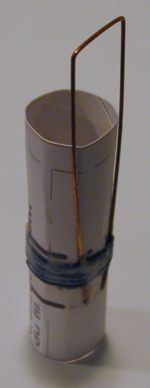 Next, comes the card-stock motor tube. I struggled with the
markings and the instructions on this a bit. However, the basic concept is that
an 18mm motor needs to fit in it, so I grabbed one to test out the size. Once I
did that then I could understand where the template lines were supposed to line
up. The motor tube is just a piece of wrapped card-stock. Next a wire hook is
added. This is a nice design and I wouldn't mind seeing this on regular 18mm
rockets. The wire inserts into two holes and extends into the tube to act as a
motor thrust stop. It then over hangs to act as motor retention. The wire is
"strapped" to the motor tube by wrapping a black thread around and
around and around it. I didn't measure the length, but it was long. Once
wrapped it is soaked with glue. It made for a good strong motor tube.
Next, comes the card-stock motor tube. I struggled with the
markings and the instructions on this a bit. However, the basic concept is that
an 18mm motor needs to fit in it, so I grabbed one to test out the size. Once I
did that then I could understand where the template lines were supposed to line
up. The motor tube is just a piece of wrapped card-stock. Next a wire hook is
added. This is a nice design and I wouldn't mind seeing this on regular 18mm
rockets. The wire inserts into two holes and extends into the tube to act as a
motor thrust stop. It then over hangs to act as motor retention. The wire is
"strapped" to the motor tube by wrapping a black thread around and
around and around it. I didn't measure the length, but it was long. Once
wrapped it is soaked with glue. It made for a good strong motor tube.
The next step is to cut out the foam board using the templates provided. These form the centering rings for the motor tube. Once glued to the motor tube, the assembly is then pushed into the rear of the main body. The shape for the centering rings form the shape of the rocket (away from a circle). This assembly is set aside.
The fins are then cut out from the card-stock, assembled and attached. I didn't have any issues with the fins.
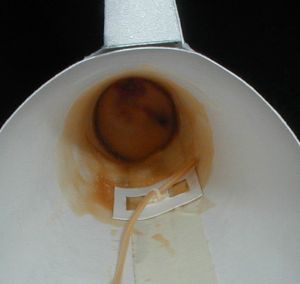 Next, the parachute is assembled using masking tape to make the
corner tabs and the nylon thread provided for the shroud lines. Once assembled,
this is attached to the motor mount assembly.
Next, the parachute is assembled using masking tape to make the
corner tabs and the nylon thread provided for the shroud lines. Once assembled,
this is attached to the motor mount assembly.
Finally, the rubber band is attached to inside of the main body and then tied around the motor mount. I was not pleased with the length of the rubber band so added some Kevlar®. Normally, I tried to build kits per instructions for the sake of doing an accurate review, however, if you notice in the picture, this would have been very foolish.
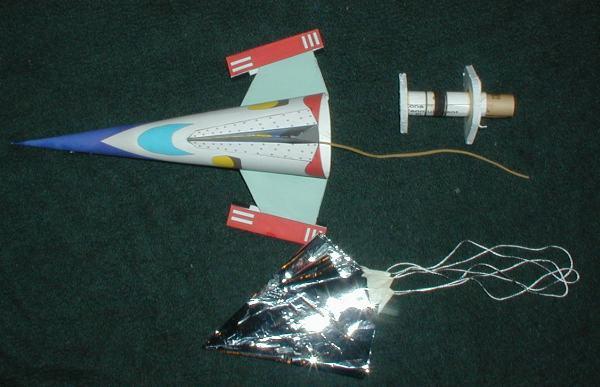
Fold the parachute and hold it in the space between the two centering rings and slide the assembly into the rear of the main body. Turn is slightly, as needed, to make the lower fins symmetrical.
Finished . . . well, almost. No launch lug! The instructions didn't cover it, but I mounted my launch lug up near the tip and put an extra piece of card-stock(from the template that was not discussed either) over the launch lug.
Overall, for CONSTRUCTION I would rate this kit 3 points. Here's the deal. If this was a normal packaged kit, it would have rated lower, but because this is my first "paper" rocket I'm not sure what to expect. The instructions are excellent with the following important exceptions, 1) no mention of the launch lug and 2) English translation. The construction materials are fine with the exception of the rubber band shock cord. The motor tube and retainer are great.
FLIGHT/RECOVERY:
Model Minutes story behind the Space Racer goes like this: "Each year close to the nebula of the eagle proceeds the great race of space. The runners bring to it their small vessel of race colourful and often manufactured starting from parts recovered here and there. The spectacle of these small apparatuses foncant at all speed through stars and asteroides is worth really small turning a 72 years lights. Will dare you to be registered?" I typed this exactly off of the cover page of the Space Racer instructions. I like the fact that there is a story behind the rocket. So yes, I dare to be registered with my new Space Racer!
Model Minutes recommends flights on B4-2, B6-2, C6-3 and C5-3 with the predicted altitudes between 200 and 400 feet. These appear solid since my rocket weighed in at 2.1 ounces.
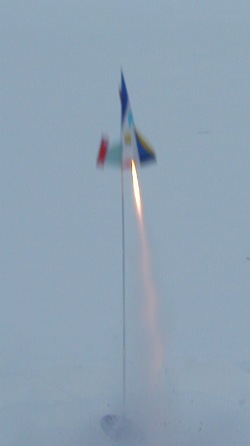 For my first flight I folded the parachute and placed it in the
gap between the centering rings. I then wrapped with with a couple sheet of
Estes wadding. I placed the shockcord in the gap and slid it into the rear of
the rocket. In inserted a B6-4, since I didn't have a B6-2. I then drove to my
field in the 21 degree weather of Vermont's January 25th with my son.
For my first flight I folded the parachute and placed it in the
gap between the centering rings. I then wrapped with with a couple sheet of
Estes wadding. I placed the shockcord in the gap and slid it into the rear of
the rocket. In inserted a B6-4, since I didn't have a B6-2. I then drove to my
field in the 21 degree weather of Vermont's January 25th with my son.
After a quick (remember how cold it is) countdown my son pushed the launch button, I snapped this picture, and off flew the Space Racer. It had an extremely fast spin going up, but nonetheless, straight and stable. It arced over at apogee and started heading down. Just about 2 seconds past it popped the ejection. It kept falling fast and then about 20 feet from the ground the parachute opened and it landed. The nose was about 4" into the snow when I got there, but no damage at all.
I blew off all the snow and installed a C6-3. We launched it and found that it did not spin as much going up. The placement of the motor mount can change the angle of the fins, so this must have been more symmetric. I probably flew to about 250 feet or so, arced and ejected at apogee. The parachute opened right way. It fell swiftly.
Upon inspection, the parachute was burned in a couple of places and one shroud line was burned through. I didn't wrap it in the Estes wadding for the second flight so that could have caused this.
The rocket is rear-ejection and therefore the tip of the rocket comes down first. I believe it was a good thing to be flying in the snow, because any hard ground would bring a lot of damage to the nose tip. It might be a nice modification to create a sling-recovery so that it comes down horizontally.
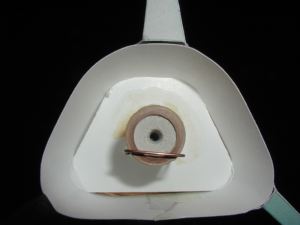 For FLIGHT/RECOVERY, I would rate this kit
4
points. The flight of the Space Racer is something unique and the
recommended motors appear to give perfect apogee ejection. The parachute is
sized good, but the tip of the rocket would probably get damaged over time. I
already dinged the ratings for the rubber band shockcord. Protection of the
'chute is important in this design.
For FLIGHT/RECOVERY, I would rate this kit
4
points. The flight of the Space Racer is something unique and the
recommended motors appear to give perfect apogee ejection. The parachute is
sized good, but the tip of the rocket would probably get damaged over time. I
already dinged the ratings for the rubber band shockcord. Protection of the
'chute is important in this design.
I give the kit an OVERALL rating of 3 points. Since this was my first paper rocket build, it is hard to rate for comparison sakes, but I was not turned off and am looking forward to doing a few more. The rocket's looks along should inspire some to order and build it. The experience of the paper build should also be something that modelers would like to attempt. The motor retention is great. I think I'm going to order a package of just those wires for future 18mm rockets. They would probably work for 24mm too.

(Contributed - by Chan Stevens)
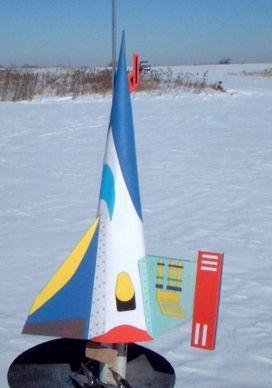 Brief:
Brief:
Model Minutes' Space Racer is an excellent first venture into the world of
paper rocketry. With it's futuristic design and bold color scheme, it's sure to
draw the attention of kids and adults alike.
Construction:
The kit contains:
- High-quality color cutouts for body and fins, motor tube
- Foam board for centering rings
- 2-pronged wire motor hook
- 9" mylar chute/rubber shock cord
- Clay nose weight
This kits is described as a skill level 1 beginner kit and if you've had previous experience with paper rockets, that's accurate. If you've never built a paper rocket though, I would rate this at least a 2 or 3.
Since Model Minutes is a Canadian company and their primary language is French, the instructions lose a little bit in the translation. You'll need to pay careful attention to the illustrations to make sure you understand what's required. The illustrations are quite helpful, with 3-D photos that must be viewed through the hokey red/blue shaded glasses. Looking over their website, this appears to be an attempt to prevent piracy of their plan packs and I could have done without the 3-D goggles under fluorescent lighting. To each his own though, and I'm sure some people will love this touch.
Construction consists of cutting/forming the body shroud then adding nose weight (a must for stability--don't go light here). Next comes the motor tube with a unique motor hook approach. They use a U-shaped hook with the ends of the U poking through the tube and the loop extending beyond the tube to act as a hook. The hook is kept in place by a healthy wrap of thread.
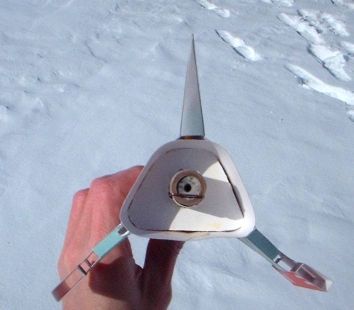 The
motor tube is centered through foam cutout "centering rings". Rings
isn't exactly right, as this is more of a trapezoid pattern (see photo). The
instructions cover two different mounting options and I couldn't quite tell
what the difference between was so opted for the first. My guess is that the
optional approach uses 1 fixed centering ring, while the standard approach uses
none (both are rear ejection).
The
motor tube is centered through foam cutout "centering rings". Rings
isn't exactly right, as this is more of a trapezoid pattern (see photo). The
instructions cover two different mounting options and I couldn't quite tell
what the difference between was so opted for the first. My guess is that the
optional approach uses 1 fixed centering ring, while the standard approach uses
none (both are rear ejection).
The next phase of construction is cutting/forming/attaching the fins and rudder. There are several intricate folds, so care must be used on this step. I opted for a very thin film of white glue for the paper bonds, as it dries clear and is not as brittle as yellow glue. You're supposed to cut out two tiny holes in the edge of one fin for a launch rod. I looked at the fin edge, which was barely 1/4" to begin with, and decided this was not going to hold up very well, so I inserted a standard 3" long Estes launch lug inside for reinforcement.
Installation of the recovery gear is fairly straightforward, with a paper shock cord mount, tied around the motor tube (rear ejection), and finished off by attaching the 9" mylar chute.
Finishing:
There's nothing to finish, as the model is pre-printed/colored paper. Clear
coating might not be a bad idea, but I was afraid of the ink running, so went
with the untreated finish.
Construction Rating: 4 out of 5
Flight:
First flight was on a clear, winter day, temperatures around 10 degrees, and
not a trace of wind. I went with the C6-5, although I got what seemed like a
longer delay (two from same pack acted like 7's).
The flight path was remarkably straight--all that nose weight paid off. The deployment was definitely late, but as noted, this could be a motor problem more than due to the design.
Recovery:
Unfortunately, the combination of paper cone-shaped nose, nose weight, and rear
deployment resulted in a "lawn dart" landing, albeit it gently under
the chute and in a soft bank of snow. Still, the sharp pointed nose is now
blunted.
Flight Rating: 4 out of 5
Summary:
Very cool looking, a fun build, and even more fun to fly. This is not a very
durable design though, so enjoy it while you can.
Overall Rating: 4 out of 5
 |
 |
Flights
Sponsored Ads
 |
 |











